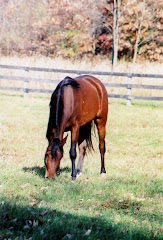
There is a lot across the street from my parents house at the ocean where I spent many happy hours as a child, galloping along twisting paths of grassy sand dunes, pretending I was a wild stallion protecting my herd. For whatever reason, 40+ years later this little piece of earth is still untouched. Whenever I am in Bay Head, the first thing I do each morning is look out my bedroom window, across the top of those same sand dunes, to see the sun rising over the ocean.
Like all good horse girls, my imagination allowed me the power to tame many a wild stallion purely through my gentle nature, or to become that wild stallion, or a mare who had strayed from his herd with my newborn foal. But never did I ever imagine capturing the wild horses in my mind, forcing them into work, to live in a stall, away from their native land where they ran so wild and free.
I think I first read Black Beauty about the same time I saw the movie Born Free. I was nine years old (and I did
not read an abridged version) and very moved by the words on those pages. It was reading Black Beauty that made me decide I wanted to be a writer, and I wanted to write about horses. I wrote several stories as a child, which ~ thanks to my sentimental and thoughtful mother ~ I still have today. Little pages stapled together, complete with illustrations, all about wild horses resisting being tamed and a girl who sets them free.
In thinking recently about the wild mustangs plight happening right now, and watching the videos posted on the internet of the "gatherings" as the BLM gently refers to them, I remembered a poem I wrote one day after I came in from the sand dunes. I found it in my box of childhood treasures and thought I would share it with you. Following is how it was written when I was 9 years old:
Wild and FreeThis one shall never feel the pain
Of stinging whip or bearing rein,
For he is born so wild and free
Just like all others were meant to be.
Out on the prairie, his mother near,
He doesn't yet know the meaning of fear,
But soon he will learn to run like the wind,
When man comes after day out and day in.
For if they catch him (the thought is ill),
They will teach him to go only at their will,
And never again will he ever be,
Running and living so wild and free.
Nanci Tuner
Age 9
 As I prepare for the Mustangs on the Hill Rally tomorrow, I have been thinking a lot about wild ponies in general. I want to share with you an organization that helps children buy Chincoteague ponies each year at the round up made famous by Marguerite Henry in her book Misty of Chincoteague.
As I prepare for the Mustangs on the Hill Rally tomorrow, I have been thinking a lot about wild ponies in general. I want to share with you an organization that helps children buy Chincoteague ponies each year at the round up made famous by Marguerite Henry in her book Misty of Chincoteague. 








 suggests a Haflinger cross.
suggests a Haflinger cross. +of+DallasGrazing.jpg)


